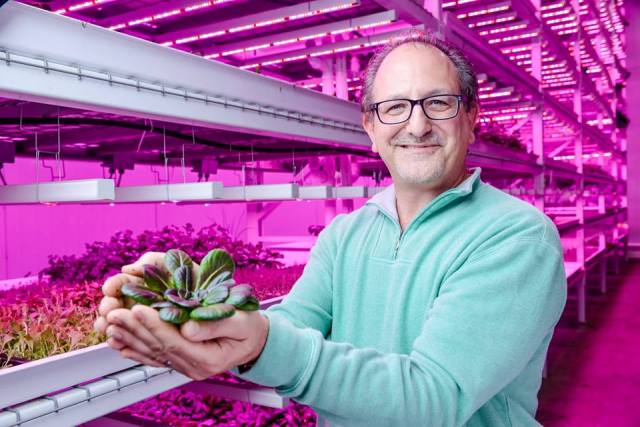Green Sense Farms Scraps Sun For LEDs
By Melissa Wiley in Food on Jul 24, 2014 4:00PM

Green Sense Farms President and Founding Farmer Robert Colangelo. (Photo via Green Sense Farms Facebook page.)
If Willy Wonka were a farmer, he would have started Green Sense Farms. As it is, Robert Colangelo got there first, using LEDs to grow his kale and chives just across the Indiana border.
“Cars used to run off of just one fuel, gasoline, but now they run off a spectrum, one that will only diversify further with time. In the future, I see farming stratifying in the same way. I think field farming will always work well for commodity crops like corn and wheat. Greenhouses will always be great for growing tomatoes and peppers, while indoor vertical farms like ours will be best for leafy greens, microgreens and herbs,” Colangelo, founding farmer and president of Green Sense Farms, told Chicagoist.
“Our plants look a little black under the LED lights,” Colangelo observed, “but they turn green when you bring them under the sun. I love when people walk through our facility and taste the freshness of what we produce. That’s the most satisfying aspect of this for me personally. Our goal is to get our produce from farm to table in 24 hours.”
That’s faster than most local farms can manage, as Colangelo is quick to acknowledge. “Most local farms still have to pick their produce from the field and then transport it from the field in a truck, so their farm-to-table time has to be longer.”
Farming minus sun and soil—the plants are grown in coconut husks optimized for moisture retention—has other market advantages too besides efficiency that approaches the speed of light.
“When you’re in Chicago in February and the winds are whipping at 20 degrees below, we’re the only local farmer around. So stores and restaurants like us for that. They can get produce from us 365 days a year, pesticide free and local. We’re only 45 min away from Chicago and we grow year round. That’s what sets us apart.”
And color, Colangelo says, is key.
“Solar power has a broad spectrum of light and high intensity, but sun doesn’t shine all the time. When you look at the light spectrum, plants don’t need a wide range of color. Photosynthesis happens within the red and blue parts of the spectrum, so LED lights use low energy and give off little heat.”
So given that sunlight's a wash, why has Green Sense rooted itself in Portage rather than in Chicago, closer to many of the restaurants it’s seeking to supply?
“We strategically put our farm here in Portage because we’re close to several interstates, so we can service a five-state area and still function as a local farm. We sell to Whole Foods, whose regional headquarters is in Munster, Ind. Right now, we sell primarily to wholesale resellers and are looking at servicing select restaurants.”
Urban farming, he concedes, also lacks certain attractions.
“City farming is a bit of a misnomer. To build an inner-city farm is very expensive. We’re a large commercial production and yield roughly 3,000 cases of produce a week. If we were in Chicago, our rent would be high, as would our utilities, and we’d all be fighting traffic. Our input costs are lower here, yet we can easily service the whole Chicago market.”
“The key is working within a distribution network already in place,” he reminded us by way of reiterating Green Sense’s conservation ethos. “We want to break into the Chicago market with microgreens like kale and arugula. A lot here are coming from East and West Coasts, and we’d like for people to taste something fresh all year round.”
Does this mean Green Sense Farms aspires to service only a small radius of consumers? Well, yes and no.
“We’ll be opening additional farms in other areas of the country in future, but we’re always going to stay local. We want to become a national brand that remains a local farm in its area so that we conserve as many resources as possible, including fuel for transport.”
Colangelo didn’t start out as a farmer himself, it’s worth taking note, but his commitment to sustainability is what led him here, to possibly the world’s most climate-controlled farm.
“I was teaching a workshop on building sustainable communities and started a radio show called ‘Green Sense,’ where I interviewed entrepreneurs on sustainability, and food and urban farming kept coming up. After a while, I thought, ‘This is a trend, not a fad.’ I had a friend who developed the technology, and after five years we perfected it then rolled it out on this large scale. We’ve had many iterations, but now we’re commercially viable.”